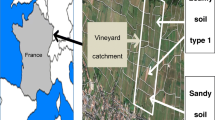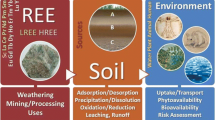Abstract
Rare-earth elements (REEs) have been used in fertilizers in the agriculture of China for about 20 years. They have been shown to be beneficial elements for plants. For example, they have improved the yield and quality for several kinds of crops. This paper reviews the current literature on studies of REEs being used as fertilizers. Some studies have focused on the effects of REEs on metabolic nutrients, photosynthesis and stress resistance of plants. Other studies have shown that the environmental behaviors of REEs in soil are dominated by their low solubility. Fluorides, carbonates, phosphates and hydroxides may form neutral complexes containing REEs with a low solubility. The amount of extraneous REEs demonstrate the following relationship: residual» bound to organic matter> bound to Fe-Mn oxides> bound to carbonate»exchangeable and water soluble forms. The adsorption capacity of REEs depends on the clay type and the content of amorphous and manganese oxides, whereas the desorption of REEs is usually very low. At the end of the paper, authors discuss the needs for future environmental research on REEs, which would shed new light on the effects of REEs on agriculture, environment and human health.
Similar content being viewed by others
References
Chang J (1991): Effects of La on cell penetrating and nutrient absorbing in root of rice and wheat. Chinese Plant Physiology Communication27 (1) 17–21
Chen ZX, Wang XR, Tian LQ, Dai LM (1995): Simulation study in the effects of acid precipitation on the environmental chemical behavior and plant utility of REEs. Acta Sci Circums15 (1) 32–38
Chu ZX, Mu MH, Wang FZ, Shao HX (1996): Effects of CeCl3 on the photosynthesis of plants in relation to Fe2+. Proceeding of the first Sino-Dutch workshop on the environmental behavior and ecotoxicology of rare earth elements, Beijing. pp 75–81
Diatoloff E, Smith FW, Asher CJ (1995c): Rare earth elements and plant growth: Response of corn and mungbean to low concentrations of cerium in dilute, continuously flowing nutrient solutions. Journal of Plant Nutrition18 (10) 1991–2003
Diatoloff E, Smith FW, Asher CJ (1995a): Rare earth elements and plant growth: Effects of lanthanum and cerium on root elongation of corn and mungbean. J Plant Nutr18 (10)1963–1976
Diatoloff E, Smith FW, Asher CJ (1995b): Rare earth elements and plant growth: Response of corn and mungbean to low concentrations of lanthanum in dilute, continuously flowing nutrient solutions. J Plant Nutr18 (10)1977–1989
Guo BS (1993): The Application of rare earth elements on agriculture and breeding. Chinese Rare Earth15 (6) 37–43
Guo BS, Zhu WM, Xiong BK (Eds) (1988): Rare earth elements in agriculture. Chinese Agriculture Press, Beijing, pp 117–119
He YZ, Wang JF, Fang NH, Gan WE, Zhao GW (1998): Effects of rare earth micro-fertilizer on plant physiological indexes and yield of hot pepper. Chinese Rare Earth19 (2) 36–40
Hong WM, Duan XB, Gao ZS, Hu CP, Zheng W, Qu HJ (1996): Long-term location test of REE on agriculture and REE residual analysis in wheat seeds. Proceeding of the First Sino-Dutch Workshop on the Environmental Behavior and Ecotoxicology of Rare Earth Elements, Beijing, pp 83–87
Hu QH, Ye ZJ (a1996): Physiological effects of rare earth elements on plants. Chinese Plants Physiology Communication32 (4) 296–300
Ichihasshi H, Morita H, Tasukawa R (1992): Rare earth elements in naturally grown plants in relation their variation in soils. Environment Pollution76 157–162
Ishikawa S, Wagatsuma T, Ikarashi T (1996): Comparative toxicity of A13+, Yb3+ and La3+ to root-tip cells differing in tolerance to high A13+ in terms of ionic potentials of dehydrated trivalent cations. Soil Sci Plant Nutr42 (3) 613–625
Kinraide TB, Ryan PR, Kochian LV (1992): Interactive effects of trace heavy metals: indium and dysprosium in red alder roots (Alnus rubra Bong). Environ Exp Bot21 (2) 217–223
Lai ZS, Wen QK, Zhao WH (1989): Studies on the effects of rare earth elements on tomato yield and quality. Chinese Rare Earth10 (3) 659–62
Liu DY, Wan ZL (1993): Studies on the effects of rare earth elements on wheat nutrient transferring. Chinese Rare Earth14 (1) 60–64
Liu SJ, Zhang S, Wang LJ, Gao XJ (1996): The effects of long-term foliage-dressing with micro-fertilizer of rare earth elements on contents, distribution patterns and accumulation of REES in soil-spring wheat system. Proceeding of the First Sino-Dutch Workshop on the Environmental Behavior and Ecotoxicology of Rare Earth Elements. Beijing, pp 143–150
Liu YL, Liu JH, Wang ZJ, Peng A (1999): Speciation transformation of added rare earth elements in soil. Environmental Chemistry.18 (5) 393–397
Markert B (1989): The pattern of distribution of lanthanide elements in the soils and plants. Photochemistry26 (12) 3167–3170
Nari RR, Gupta PN, Valiathan MS, Kartha CC, Eapen JT, Nari NG (1989): Enhanced cerium concentration in magnesium-deficient plants. Current Science58 (12) 696–697
Ning JB, Xiao SL (1989): Effects of rare earth elements application on day lily. Chinese Rare Earth10 (5) 52–54
Peng A, Wang ZJ (1996): Recent research progress on environmental chemistry of rare earth elements. Proceeding of the First Sino-Dutch Workshop on the Environmental Behavior and Ecotoxicology of Rare Earth Elements, Beijing, pp 126–130
Pham Thi Huynh M, Carrot F, Chu Pham Ngoc S, Dang Vu M, Revel G (1997): Determination of rare earth elements in rice by INAA and ICP-MS. J Radioanal Nucl Chem217 (1) 95–99
Ran Y, Liu Z (1993): Adsorption and desorption of rare earth elements on soils and synthetic oxides. Acta Science Circumstance15 (1) 57–65
Ran Y, Liu Z (1992): Adsorption of REEs on soil and oxides as well as the mechanism. Bulletin Science18: 1705–1709
Sun KX, Zhang SY, Jia WX (1986): Analysis of rare earth elements content in food in China. Chinese Environment Science16 (6) 73–77
Tang XK, Tong Z (1988): Effects of rare earth elements on plant root growth and activity. Chinese Rare Metal5: 22–24
Tang XK, Tong Z (1988): Effects of rare earth elements on plant root growth and activity. Rare Metal5: 22–24
Velasco JR, Domingo LE, Lansangan AS, Sierra ZN (1979: Cultural studies on coconut cadang-cadang: reaction of plants to the rare earths, thallium and certain soil samples. Philippine Journal Coconut Studies4 (1)1–5
Volokh A, Gorbunov A, Gundorina SF (1990): Phosphorus fertilizer production as a source REEs pollution of the environment. The Science of Total Environment95: 141–148
Wang JS, Guo CR, Cheng YX (1997): Mechanism of cerium ion clearing Superoxide radical. J Chinese Rare Earth Society15 (2) 151–154
Wang LX, Xu Z, Wu XY (1985): Effects of rare earth elements on photosynthesis of fixing-nitrogen alga. J Chinese Rare Earth Society3 (3) 72–75
Wang XZ (1994): The physiological mechanism of rare earth application in agriculture. Chinese Rare Earth15 (1) 47–51
Weltje L (1997): Uptake and bio-concentration of lanthanides in higher plants: linking terrestrial and aquatic studies. Proceeding of the 2nd Sino-Dutch workshop on the environmental behavior and ecotoxicology of REEs and heavy metals, Delft, The Netherlands. pp 1–12
Wen QK, Lai ZS, Fang B (1992): Research on the effects of rare earth elements on defending drought of maize. Chinese Rare Earth13 (1) 64–69
Wu Z, Guo BS (1995): Application of REEs in agriculture and medicines, In: Bio-inorganic chemistry of rare earth elements. G. Ni (ed.), Science Press, Beijing, pp 13–15
Wu ZM, Li JG, Tang XK (1995): New frontiers in rare earth science and applications. Vol Science Press, Beijing, p 1515
Wu ZM, Tang XK, Jia ZW, Gao XX (1984): Studies on the effect of rare earth elements on the increasement of yield in agriculture. 2. Effects of rare earth element on physiological metabolism in crops. J Rare Earth Society2 (2) 75–79
Xie HG, Chen FM (1984): The effects and technique of rare earth elements on sugar beet. Heilongjiang Province Agriculture Science1, 8–10
Yan ZL, Hong YT, Lin P, Wang SJ, Yang XK, Fu SZ, Zhu KY, Wu SY (1999): The effect of acid rain stress on membrane protective system of spinach and the conservation of rare earth elements. Acta Ecologica Sinica19 (4) 543–545
Yan ZL, Hong YT, Yang XK, Fu SZ, Wu SY (1998): The effects of rare earth elements on wheat under acid rain stress. Chinese Agricultural Science31 (3) 89–91
Yang JP, Zhang SY (1986): Studies on rare earth elements enhancement defending stress of wheat. J Chinese Rare Earth Society4 (4) 67–70
Yu Z. Chen M (Eds) (1995): Rare earth elements and their applications. Metallurgrical Industry Press, Beijing. pp 286
Zhang S, Wang LJ, Gao XJ, Liu SJ (1996): The abundance, form and distribution of rare earth elements in soil of China. Proceeding of the first Sino-Dutch workshop on the environmental behavior and ecotoxicology of rare earth elements, Beijing. pp 151–159
Zheng SQ, Peng T, Zhang ZD (1993): Effects of rare earth elements on seed emergence and root growth of vegetables. Chinese Rare Earth14 (3) 60–62
Zhou Q, Huang XH, Huang GY, Zhang JH, Peng FQ, Tu KG (1999): Effect of La on Glycine max seedling under Pb stress. Chin. J Appl Environ Biol5, 22–25
Zhou Q, Huang XH, Tu KG, Huang GY, Zhang JH, Cao YH (1998): Ecophysiological effect of La on Glycine max seedling under Cd stress. China Environmental Science18, 442–445
Zhu JG, Xi GX (1992): Study on the chemical form of REEs in soil by sequential extraction. Soil24 (4) 215–218
Zhu JG, Zhang YL, Yamasaki S, Tsumura A (1996): Water soluble rare earth elements in some soils of China. Proceeding of the first Sino-Dutch workshop on the environmental behavior and ecotoxicology of rare earth elements, Beijing. pp 133–141
Author information
Authors and Affiliations
Rights and permissions
About this article
Cite this article
Pang, X., Li, D. & Peng, A. Application of rare-earth elements in the agriculture of China and its environmental behavior in soil. Environ Sci & Pollut Res 9, 143–148 (2002). https://doi.org/10.1007/BF02987462
Received:
Accepted:
Issue Date:
DOI: https://doi.org/10.1007/BF02987462




